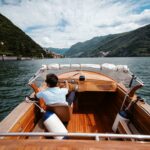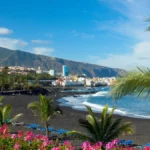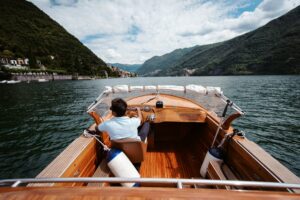The lake trout must have been hungry. Only five minutes after our guide, Marina Alexander, had rigged the fishing lines off the northeastern tip of Isle Royale, an island in Lake Superior, I reeled in a two-pounder. Its mottled, silvery body glistened in the sun. “Catching a lake trout is fun,” Alexander told my partner, Brian, and me, “but catching salmon is more fun. They are so pissed off when they get caught that they will work you.”
Alexander, who is 28, has spent every summer of her life in Isle Royale National Park, an archipelago of more than 400 islands. The park encompasses a total area of 850 square miles, and 99 percent of it is designated wilderness. Four-fifths of the park is water, part of one of the largest bodies of fresh water on earth. At its center is the 45-mile-long, nine-mile-wide Isle Royale.
:max_bytes(150000):strip_icc():format(webp)/TAL-moose-in-greenery-ISLEROYALE0724-1248bda6e9ab4e9ea7f065a0a7809309.jpg)
Options for getting to the car-free island are limited. You can arrive by floatplane or ferry from just four spots in Michigan and Minnesota (unless you have a private boat). And the winter weather is harsh, so the park is open for only half the year. As a result, Isle Royale is often referred to as one of the most remote and least-visited parks in the United States.
So what’s the attraction? Visitors can find real solitude in a wilderness that feels untamable, despite a human history that dates back thousands of years. While introduced by the original seasonal inhabitants — the Anishinaabe — the practices of mining, fishing, and logging became official industries after Europeans made their way to the islands. In 1855, the Soo Locks — a system allowing freighters to navigate the waterways of the region — opened Lake Superior to the world, boosting tourism to the islands. Worried Isle Royale would continue to lose pristine natural habitat, seasonal residents successfully lobbied Congress to designate it as a national park; it was made official in 1940.
Today, Isle Royale remains an oasis in an inland sea, with thick pine forests and wildlife — nearly 900 moose are kept in check by the islands’ wolf population, which hovers at around 30. To explore, visitors must travel by foot on the island’s 165 miles of hiking trails, which lead to vast inland lakes, follow a mountainous ridgeline, and trace a dramatic, rocky shore.
I grew up in Minnesota, on the western tip of Lake Superior, but had only been to Isle Royale once, a decade ago, on a four-day solo hiking trip. Friends have circumnavigated the island by kayak, scuba-dived among the shipwrecks that lie in the reefs, and sailed from the mainland to moor in a tucked-away harbor. But I prefer the simplicity of backpacking. After a long time away, I felt a strong urge to return and share this magical place with my partner.
As with many U.S. national parks, interest in Isle Royale is rising. Visitation to the island reached a record 21,654 people in 2023. That may sound paltry compared with other parks, but the increased traffic has strapped Isle Royale’s overnight accommodations. They consist of just two places, Rock Harbor Lodge and Washington Harbor Camper Cabins, as well as campgrounds scattered around the island. (You can also sleep on your own boat.)
We took our chances on finding a campsite for two nights, and also booked — six months in advance — two nights at a Rock Harbor Lodge. Our cabin had large windows overlooking Tobin Harbor, providing a pleasant view of seaplanes landing from the mainland.
When we had arrived by seaplane two days earlier, in uncharacteristic late-afternoon heat, we hustled along the island’s Rock Harbor Trail, hugging the southern shoreline for three miles to discover that the first campground, Three Mile, was full. We were debating whether to hike four more miles to the next one when a sympathetic backpacker invited us to join a group site where three of his buddies and two other sets of strangers had pitched their tents. We boiled water for pasta, swapped stories with our new friends, and turned in early.
Waking at dawn, we headed down the trail to Daisy Farm Camp. With a large dock for incoming boats, pebbly beaches, and private screened shelters, it is a popular destination. We reached it by 11 a.m. and found an empty hillside shelter surrounded by pines where we dropped our heavy packs. Free to explore for the rest of the day, Brian and I hiked inland, a mile and a half up the Mount Ojibway trail, climbing down through dense woods, through lowland swamps, and to a rocky ridgeline, where we stopped to pick plump blueberries.
We walked on in the almost-90-degree heat, finally finding ourselves far enough from the park entrance to enjoy true solitude. Continuing the route, we ended up on a five-mile loop of Lake Ojibway, one of Isle Royale’s 200 inland lakes and ponds.
Parched after this 10-mile day, we wandered down to the Daisy Farm Camp dock with our water filters, where we greeted an older couple enjoying cocktails on their cabin cruiser. Like other visitors with private boats, they were willing to make the potentially perilous crossing from the mainland.
Over the course of five days, Brian and I hiked some 40 miles and caught (and released) seven lake trout. On one of our final journeys, returning to the entrance of Rock Harbor Trail drenched in sweat after a seven-mile hike, we climbed just out of sight, stripped off our clothes, and waded into Lake Superior. The chill zapped my limbs like an electric current. Just as I was ready to bare myself on shore, the tour boat Sandy rounded the point with a few dozen waving passengers, forcing me to stay submerged until they passed, the water piercing my fingers and toes like tiny icicles.
While submerged, I thought of other, more serious ways to get in trouble on Isle Royale. Throughout our trip, we heard stories of the dark days of winter on the islands and of shipwrecks caused by ferocious storms. Alexander shared a time she faced a potentially fatal incident while piloting a 24-foot boat: she had to outrun a black squall. Despite these moments of terror, she said, “I love storms out here. The weather is humbling.”
That sense of nature’s power is what keeps me (and many others) intrigued. For thousands of years this archipelago has held its own, buffered from development by a lake that has been impossible to tame, as hard as humans may try.
Where to Stay
Rock Harbor Lodge, with cabins and hotel rooms on the northeastern end of Isle Royale, is the island’s only full-service lodging facility and is open from June to September. The two rustic Washington Harbor Camper Cabins, on the southwestern end, are the other option. There are 36 official campgrounds, which are first come, first served (but must be reserved for groups of seven or more). The two most popular are Washington Creek and Daisy Farm.
How to Get There
Cars are not permitted on Isle Royale. The starting points for reaching the national park are Houghton and Copper Harbor, in Michigan, and Grand Portage and Grand Marais, in Minnesota. From there, you can transfer to the island via seaplane, ferry, or a boat rental, depending on the port.
If coming by private boat, call the Houghton Visitor Center ahead of time to get a docking permit.
Best Time to Visit
Because of the extreme winter weather, visitors are only allowed on the island from mid-April to October 31; peak season is May through September.















